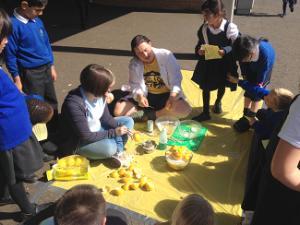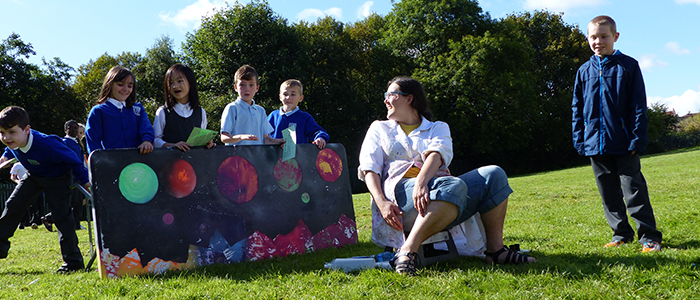Make a lava lamp
Follow the instructions in the video to make your own fizzing lava lamp!
Fizzy rockets
To make a rocket fly upwards into space, we need a force in the opposite direction that is strong enough to propel it upwards.
For the fizzy rocket experiment we are using a vitamin tablet as rocket fuel. When the tablet is mixed with water it fizzes and releases bubbles of carbon dioxide (CO2).
The bubbles build up enough pressure to push down onto the film canister lid and force it off. It is this downwards action that pushes the rocket upwards in the opposite direction.
Download the Fizzy rocket instructions and template
Lemon Volcano
 In this activity you can make a lemon volcano!
In this activity you can make a lemon volcano!
Lemon juice is very acidic because it contains citric acid which gives it that sour taste. Citric acid is found in lots of fruit and fizzy drinks, too much can be bad for your teeth.
When you mix an acid like citric acid with an alkali, there is a chemical reaction. Bicarbonate of soda is an alkali. When it’s added to the lemon, it combines with citric acid and releases carbon dioxide, to make a lemon volcano!
You will need:
- A lemon
- Bicarbonate of soda
- Chopping board
- Knife (ask an adult to use this for you)
- Spoon
- Food colouring (optional)
- Washing up liquid
- Basin
How to:
- Place the lemon on the chopping board. Ask an adult to cut a bit off both ends of the lemon so that it sits flat and upright on a surface.
- Sit the lemon upright in the basin. Use the spoon to mash up in the inside of the lemon.
- Pour a few drops of food colouring and washing up liquid into the lemon.
- Add a spoonful of bicarbonate of soda to the lemon.
- Use the spoon to mix it a little. Watch what happens!
Download the Lemon volcano instruction sheet for full instructions and pictures.
Exothermic reaction garden gnome
In this activity you can study exothermic reactions by making a garden gnome with a colourchanging hat.
Download the full Exothermic reactions gnome activity guide
Compost Chemistry
In the soil there are lots of tiny bugs called microbes which you can’t see with your own eyes. There are more microbes in a teaspoonful of soil that there are humans on the planet!
Some of these microbes help make compost, which contains all the nutrients plants need to grow; they help keep the balance of elements such as nitrogen and carbon. The video below show you how to make your own cuddly microbe.
Make a bath bomb
Follow the instuctions in the video or download the Make a Bathbomb worksheet to make your own fizzing bath bomb.


